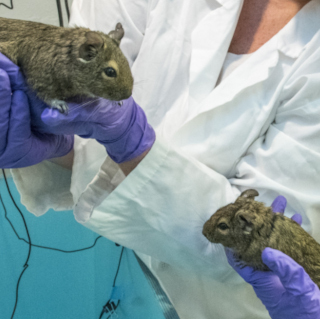Animal Transport
Last Review Date: October 27, 2022
I. Purpose
This Standard Operating Procedure (SOP) outlines the policies and procedures for transporting animals at the University of Montana Laboratory Animal Resources (LAR)
II. Policy
It is a LAR policy to meet or exceed all federal, state, and local regulations and guidelines and to comply with all institutional policies and procedures as they apply to the use of animals in research. LAR personnel or investigators involved in husbandry and care must pass online animal training modules and attend applicable training in animal care and use, occupational health and safety, and equipment operation prior to performing activities outlined in this SOP.
III. Procedures
A. Shipment of Animals
All animal delivery companies are approved delivery service providers. LAR will only allow entrance of mammals from other institutions that can provide information about the genetics and pathogen status or a Health Certificate from their Attending Veterinarian. The UM Attending Veterinarian will review all animal health records in advance of approving shipments of animals. For all species, whether SPF, conventional, or wildlife, all appropriate
B. Shipment Methods
- Rodent shipments from commercial vendors are typically shipped to Seattle via air and then transported to UM in the vendor’s environmentally-controlled truck
- Dwarf hamsters and rabbits are usually shipped by air to Missoula or Bozeman, MT and delivered by a local delivery service contracted by World Courier or Midnight Express.
- Animals shipped between UM and other Institutions are transported by a contracted commercial animal carrier.
C. Wildlife Transport Within and Into Montana
- Wild small mammals trapped in Montana may be transported in covered traps or carriers in the back of a covered pickup truck or other environmentally controlled vehicle to UM for brief testing and release back to the point of capture.
- Wild birds may be captured and transported in covered cages in a covered pickup truck for testing at the Field Research Station Fort Missoula. After testing, birds are released at their point of capture or they are euthanized.
D. Animal Transport on the University of Montana Campus
Non-infected experimental animals may be transported in their covered cages through public hallways and elevators. Cages are lightly misted with Peroxigard and placed on a rolling cart and covered with a clean lab coat or drape for transport. The cart and wheels are sprayed with Peroxigard before entering or exiting the animal facilities.
E. Procedure for LAR Acceptance of Animals
It is the responsibility of the LAR Staff to accept animals from carriers, to do the required paperwork and filing, and to let the investigator(s) know their animals have arrived.
- The animals are received at the loading dock of HS 011
- Sign for the animals from the approved delivery service
- Write the
names of investigators on the delivery packing slip
- Write the
- Find the copy of the order form on Ordering Clipboard (Health Science Office)
- Make sure it matches the animals received
- Cage cards are filled out correctly prior to animal arrival (blank cage cards are kept in HS 009)
- Animal shipment containers are lightly misted with Peroxigard and placed on a rolling cart and covered with a clean drape or lab coat for transport. The cart and wheels are sprayed with Peroxigard before entering or exiting the animal facilities.
- Unpack animals in their designated rooms
- Don gloves and lab coat
- Lightly mist outside of shipping containers and gloves with Peroxigard
- Match the correct animal count to each housing box and verify the sex of each animal
- Remove labels from shipping containers while unpacking and attached to backside of the packing slip
- Dispose of animal shipping containers in a dumpster unless saving for outgoing shipping containers
- If saving animal shipping containers, wash containers in HS cage washer and store in HS007 clean storage room
- Record the received date, species, number of animals, gender, animal strain, AUP, vender, and investigator in Transportation Log (Health Sciences Office)
- File the following documents in "Animal Order Forms Received" file in the cabinet located in the hallway outside HS 009
- Animal order form
- Order acknowledgment
- Packing slip with box labels attached
- Health report(s)
- Invoice
- USDA animal health records are placed in the USDA Records notebook and species-specific animal health records notebook
- Call or e-mail investigator(s) to let them know their animals have arrived
F. Acclimation
- Laboratory Animals
- Laboratory animals received from preferred vendors will undergo a 72-hour acclimation before being used in any IACUC-approved experiment or procedure.
- Laboratory animals transferred between main campus and the Field Station will undergo 48 hours of acclimation before being used for any IACUC-approved experiment or procedure
- Wild Animals
- Wild animals transported to the FRSFM will undergo a 72-hour acclimation before being used in any approved experiment or procedure.
